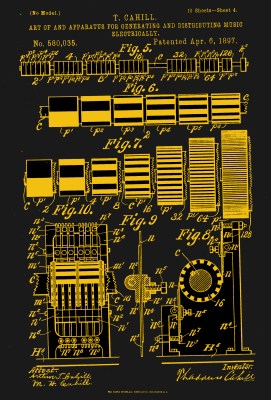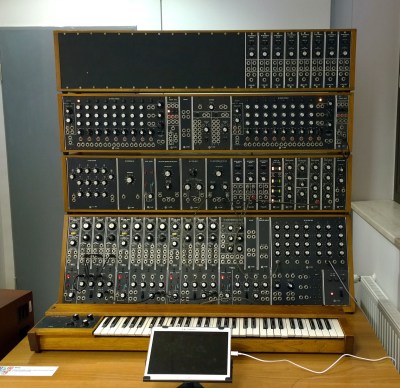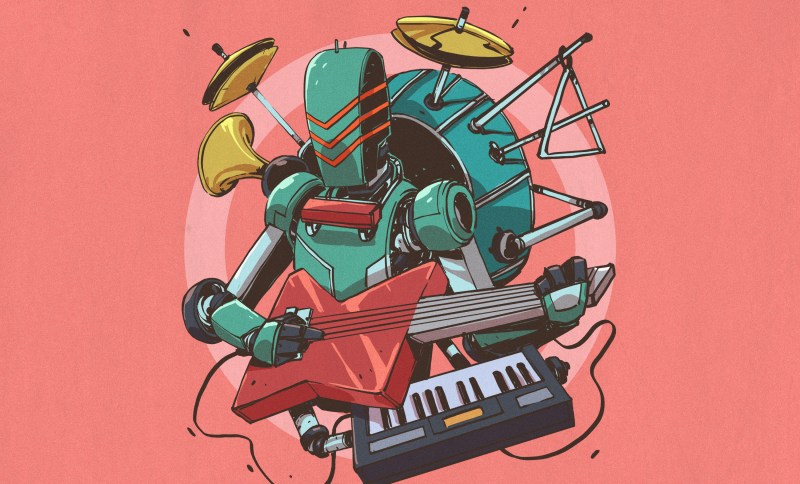A culture in which it’s fair to say the community which Hackaday serves is steeped in, is electronic music. Within these pages you’ll find plenty of synthesisers, chiptune players, and other projects devoted to synthetic sound. Not everyone here is a musician of obsessive listener, but if Hackaday had a soundtrack album we’re guessing it would be electronic. Along the way, many of us have picked up an appreciation for the history of electronic music, whether it’s EDM from the 1990s, 8-bit SID chiptunes, or further back to figures such as Wendy Carlos, Gershon Kingsley, or Delia Derbyshire. But for all that, the origin of electronic music is frustratingly difficult to pin down. Is it characterised by the instruments alone, or does it have something more specific in the music itself? Here follows the result of a few months’ idle self-enlightenment as we try to get tot he bottom of it all.
Will The Real Electronic Music Please Stand Up?

Anyone reading around the subject soon discovers that there are several different facets to synthesised music which are collectively brought together under the same banner and which at times are all claimed individually to be the purest form of the art. Further to that it rapidly becomes obvious when studying the origins of the technology, that purely electronic and electromechanical music are also two sides of the same coin. Is music electronic when it uses an electronic instrument, when electronics are used to modify the sound of an acoustic instrument, when it is sequenced electronically often in a manner unplayable by a human, or when it uses sampled sounds? Is an electric guitar making electronic music when played through an effects pedal?
The history of electronic music as far as it seems from here, starts around the turn of the twentieth century, and though the work of many different engineers and musicians could be cited at its source there are three inventions which stand out. Thaddeus Cahill’s tone-wheel-based Telharmonium US patent was granted in 1897, the same year as that for Edwin S. Votey’s Pianola player piano, while the Russian Lev Termen’s Theremin was invented in 1919. In those three inventions we find the progenital ancestors of all synthesisers, sequencers, and purely electronic instruments. If it appears we’ve made a glaring omission by not mentioning inventions such as the phonograph, it’s because they were invented not to make music but to record it.
I Never Expected To Find Myself In 1940s Cairo
Even when we’ve established the origins of the technology, the same timeline doesn’t apply to the music itself. Player pianos spent their lives banging out the show tunes of the day, and even the decidedly modern sound of the theremin found its place as a classical music instrument playing in a similar role to the violin. Perhaps the biggest surprise in all this comes in the foundations of the music we’d recognise as being purely electronic coming as late as the middle of the 20th century. The fantastically complex compositions of Conlon Nancarrow for the player piano push the boundaries far past what we’re used to in a typical sequencer file today, but it’s in music concrète, the assemblage of found sounds enabled by the development of tape and wire recorders, that we find the progenitor of sampled music. Halim El-Dabh recorded The Expression of Zaar on a wire recorder in Cairo in 1944, and for those of us who hear it for the first time nearly eight decades later it’s lost none of its haunting qualities.

As a child of 1970s, the electronic music I grew up on that was part of the broadcasting soundscape and which forms the basis of what we’d recognise as electronic music today, sounded nothing like the 1950s avant garde of music concrète or the 1930s classical music of Clara Rockmore’s theremin. Perhaps the most significant event in electronic music history wasn’t a technological one but a social one then, because the happy confluence of engineers such as Robert Moog mastering the manipulation of sound fell alongside both the huge social change of the 1960s and the solid state revolution bringing the tech within reach of the common man.
By the time I was a teenager and then a student at the end of the 1980s the democratisation process of electronic music was complete, as I or any other kid could have a keyboard or a Commodore Amiga with a sampler on their desk. If the electronic music geeks where I grew up had a star in their midst it was Adamski, who shot to fame with a keyboard and sampler on a stand without the performance of a would-be rockstar, with his name on a reflective UK car number plate.
It would be another few decades before I’d learn the nuts and bolts of making music this way, because as with amateur radio my interest was in the tech not the usage. In researching this piece then I’ve gone over a lot of instruments and techniques that I already knew something about, but the real joy has come in listening to a bunch of obscure compositions from decades past I’d never otherwise have been fortunate enough to find. If you come to electronic music via the tech then I’d urge you to open up YouTube and get searching as I did. And if you’ve got a recommendation for something we should be listening to, put it in the comments. There’s way more to the history of electronic music than Popcorn!
















Tomita
The master
Switched-On Bach was the first electronic music album I ever listened to. It was in my parent’s record collection and I must have listened to it a thousand times before I was 10 years old. A desert-island disk for sure.
Wendy Carlos’ electronic treatments of classical are timeless. I still have The Well-Tempered Synthesizer on vinyl.
All of Wendy Carlos’ electronic takes on classical have aged wonderfully. I still have The Well-Tempered Synthesizer on vinyl.
My dad had “Walter Carlos By Request” (/Wendy Carlos) which was very out of sorts for the rest of his music collection, I frickin’ loved it though – I probably picked it out for the amusing cover but remember listening to it many times.
It started with the first known electronic music instrument, the “Golden Dionysos” (pre-1752) , largely predating recording technology.
My vote for one of the first “electronic instruments” would be the the “electric harpsichord”.. 1753!
https://www.historyofinformation.com/detail.php?id=5030#:~:text=In%201759%20Jesuit%20priest%20Jean,electricity%20to%20create%20musical%20sound.
Even earlier instruments:
https://en.wikipedia.org/wiki/Spharophon
https://en.wikipedia.org/wiki/Ondes_Martenot
Not earlier than 1919 or 1897
True, that was a typo, should have been “more” but I hit send too early.
The earliest mention of an electronic instrument is “Denis d’or” (1753) which was some sort of a string instrument that used electric charges to alter the tonality, and it’s said the instrument produced electric shocks on the player.
https://en.wikipedia.org/wiki/Denis_d%27or
A buddy of mine once said that all electronic music is considered EDM. Any truth to that?
Is there any music you can’t dance to?
It does sound like the above instrument may have been performing Electrical Discharge Machining on the player, but that’s probably not a feature.
Also:
https://en.wikipedia.org/wiki/Clavecin_%C3%A9lectrique
And Elisha Gray (1876): “The Musical Telegraph used steel reeds oscillated by electromagnets and transmitted over a telephone line.”
Then there’s the Trautonium by Friedrich Trautwein (1930) which was later used by Oskar Sala to produce the soundtrack for Alfred Hitchcock’s movie The Birds.
“on December 29, 1874, Gray gave the first public demonstration of his invention for transmitting musical tones and transmitted “familiar melodies through telegraph wire” according to a newspaper announcement. This was one of the earliest electric musical instruments using vibrating electromagnetic circuits that were single-note oscillators operated by a two-octave piano keyboard. ”
That was possibly the earliest true synthesizer anyone had built.
And we can’t forget Hermann von Helmholtz!
https://www.whipplemuseum.cam.ac.uk/explore-whipple-collections/acoustics/hermann-von-helmholtz/helmholtzs-apparatus-synthesis-sound#:~:text=This%20ingenious%20device%20was%20the,the%20sounds%20of%20human%20speech.
There is also one in Haarlem, The Netherlands https://www.teylersmuseum.nl/en/collection/instruments/fk-0248-sound-synthesizer-after-helmholtz-8-resonators-and-forks
> if Hackaday had a soundtrack album we’re guessing it would be electronic
acoustic classical is pretty nice
If you want to learn more about the early history of electronic Music check the following bands/artists/resources
Yellow Magic Orchestra
https://sisterswithtransistors.com
https://en.m.wikipedia.org/wiki/Pierre_Henry
I am surprised there is no mention of the first polyphonic synthesizer – the Novachord in 1939. See https://en.wikipedia.org/wiki/Novachord
Technically the player piano gets left out because it’s digital yes but not electronic. Air! From the beginning the medium allowed non linear editing decades before tape. Punch in or take out mistakes from realtime recording, and charting a tune from sheet music to performance without musician player.
I “played” as a child with the electronic sounds coming out of a table shortwave radio in the late 1950’s finding the sounds interesting and knowing this “music” would be in our future. There was a lot of non voice activity on the bands back then, think modems running at many different speeds. An electronic jungle-forest between the BBC and belly dancing music.
A player piano could be considered a fluidic device.
Check out Conlon Nancarrow, e.g. https://www.youtube.com/watch?v=g0gNoELvpPo
I scrolled down hoping for a pic of a big Moog. I was not disappointed, thank you! What is it about lots of knobs, switches and sockets?
The first electronic music to gain wide acceptance was.by Walter Carlos in the late 60s and early 70s. His work was one to two.*decades* ahead of his contemporaries.
Switched On Bach and The Well Tempered Synthesiser demonstrated that electronic renditions of classical pieces could be at least as.good as conventional renditions (as famously.noted by Glenn Gould).
Then the soundtrack for Kubrick’s A Clockwork Orange pioneered its ordinary use in mainstream films. It was only in the 80s that popular music triumphantly rediscovered the synthesiser.
Finally, most remarkably, there is Sonic Seasonings. That pioneered “ambient music”. And you thought that was pioneered by Brian Eno, Arvo Part, and the Wyndham Hill label, but they are latecomers!
*Wendy Carlos.
Her work.
But I suspect you know that.
Some albums were released under “Walter Carlos” so some folks may genuinely not know – I didn’t for a long time until I saw a documentary about electronic music.
The 80’s discovered the drum synthesizer, which enabled a bunch of “keyboard player + singer” bands to make music.
Only loop based music that is created by sequencer or midi can be truly called electronic. As long as you had to be a keyboard player to play a synthesizer you were not fully electronic, because it required a key instrument’s player’s skill and training.
The VCS-3 was a mainstay in Brit pop early Pink Floyd etc., welcome to the machine. No keyboard, just patchboard, joystick, and all those knobs. Many LFO’s to patch to mess with things. That doesn’t repeat like loops and steppers. Very analogue the more LFO’s the better. LFO’s modulating LFO’s.
All music still requires some skill to put together, it’s just different skills.
A classically trained musician may not be able to achieve any more with a digital workstation than an electronic musician would from a Stradivarius.
I had a professor for audio production claim that any music played back by electronic means is electronic music, so whenever the first electronic playback device came into being would be the start of electronic music.
Perhaps you should mention John Chowning, CCRMA and FM Synthesis.
I wanted to mention Ugo Piatti and Luigi Russolo, with Intonarumori they build from 1910., but those were acoustic noise makers, not electronic.
Good starter for electronic pioneers is https://en.wikipedia.org/wiki/Sisters_with_Transistors
A rather long and detailed history lesson by composer David Dunn (from the early ’90s):
https://digitalmusicacademy.ru/sites/default/files/content/pioneers.pdf
There once was (it sort of still is – it’s hard to tell) this wonderful Ian Helliwell’s podcast / radio programme on early electronic music:
The Tone Generation
https://www.totallyradio.com/shows/the-tone-generation
https://www.mixcloud.com/ianhelliwell/uploads/
No mention of Kraftwerk? Hmmm.
Or Giorgio Moroder
Where did electric music start? First time guy brushed an electric eel.
digital music actually existed long before the advent of computers or even widespread use of electronics. i guess it started with things like music boxes. mechanical sequencing was well understood, so with a bit of clockwork you have the mechanical equivalent of a rom, counter, clock and dac. with just a comb, drum, and constant rpm wind-up motor and which also fits in the palm of your hand.
Jean Michel Jarre
For the first time, (for me) electronic music was not a novelty, but a mature art form.
Agreed, a brilliant electronic music pioneer, who took the kinds of Ideas Kraftwerk and Tangerine Dream were exploring, to the next level with the polished, production quality of the ground-breaking album Oxygene, followed by Equinoxe before introducing samplers with Magnetic Fields (1980) [Concerts in China (1982)] and the astounding Zoolook.
For mi, my ticket to electronic music was Jean Michael Jarre “Oxigene”, followed by Tangerine Dream, and Isao Tomita, and I was hooked for life…
Stylophophone or gtfo
comorbiid says: September 7, 2023 at 5:28 pm
*Wendy Carlos. Her work. But I suspect you know that.
My albums quite clearly state Walter Carlos, as per this image
https://images.eil.com/large_image/WALTER_CARLOS_SONIC%2BSEASONINGS%2B-%2BEX-601148.jpg
But I expect you know that.
I’ll be the first on here to mention W. Carlos’ music in the original TRON movie.
If you want the first digital electronic music created with a computer, there’s a big old system in some British museum that uses cathode ray tubes for memory. It looks like something out of a 1940’s / 1950’s SF movie with its memory CRTs sealed in a row of metal containers.
I saw it in a documentary in the 1990’s where it was mentioned that operators noticed that as the computer ran it would cause interference in nearby radios. So naturally the programmers wrote software to have the computer cause radio interference in musically rhythmic patterns. Then one of the old music programs was loaded and run with a portable radio set next to the computer to pick up the musical hum of it.
That may have been part of the inspiration to develop circuits specifically for music and converting digital data to synthesized audio.
As a slight aside, there’s an amazing history of polyphony on this YouTube series, which covers many of the instruments described here.
https://youtu.be/Yty8Rt7bzOk?si=2iykPwOUuf7B5Sb4
IMO, the basic principle of a synthesizer (building a sound from basic elements), goes back way before the first electronic instrument. The pipe organ allows you to build a sound from basic elements.
Musical electronic music of the ‘60s must include Terry Riley’s Rainbow in Curved Air and Morton Subotnik’s Silver Apples of the Moon.
Daphne Oram 1969
https://www.youtube.com/watch?v=yMvP-cxjPpo
Delia Derbyshire 1965
https://www.youtube.com/watch?v=qsRuhCflRyg